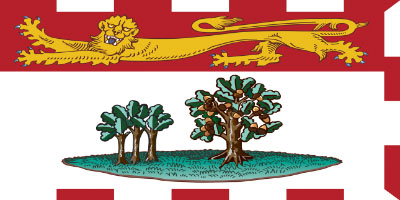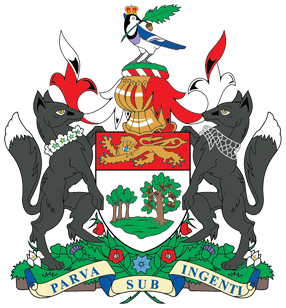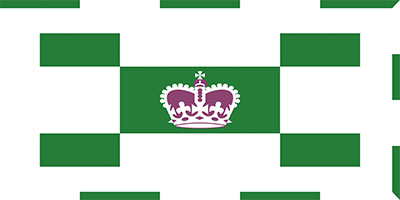Prince Edward Island, Canada
Flag
The flag of PEI was adopted by the provinces provincial legislature in 1964 and is based on the provinces coat of arms. The gold lion on a red field symbolizes the provinces ties with the United Kingdom. The large tree is the oak of England and the three saplings represent the three counties of the province. The green island reminds us that both England and the province are islands.

Other Provincial Symbols
- Floral Emblem: The Lady's Slipper
- Tartan: Prince Edward Island Tartan
- Tree: Red Oak
- Bird: Blue Jay
- Provincial Soil: Charlottetown Soil
Coat of Arms
Prince Edward Island's coat of arms, which is based on the design of the provincial great seal first used in 1769, was granted officially by King Edward VII in 1905. In 2002, a crest, supporters, compartment, and the province's traditional motto were granted by the Right Honourable Adrienne Clarkson, Governor General.

The top part of the shield features the English heraldic lion, which appears on the coat of arms of Prince Edward, after whom the province is named, and on the royal coat of arms of King Edward VII, who assigned the provincial arms. The lower part of the shield shows a green island with a large oak tree on the right and three young oaks on the left. The mature tree represents the Oak of England, while the tree saplings represent the province's three counties - Kings, Queens and Prince. The trees rise from a single base, as both Britain and Prince Edward Island are islands.
The crest combines the blue jay and the red oak leaf, two provincial emblems, with the Royal Crown, all placed on the gold helmet of sovereignty signifying Prince Edward Island's co-sovereign status in Confederation. The supporters are two silver foxes, prized local animals that indicate the importance of fur farming in the 19th and early 20th century economy of the province. Around their necks are a garland of potato blossoms and a length of fishing net, representing the agricultural and fishing industries. The compartment on which they stand includes the rose, lily, shamrock and thistle emblems of England, France, Ireland and Scotland, along with two lady slipper flowers, the provincial floral emblem. At the centre is an eight-pointed star, a symbol used for centuries by the Mi'kmaq people to represent the sun.

Origin of the Name
The province's name was adopted in 1799 to honour Prince Edward, Duke of Kent, fourth son of King George III, who was then commander-in-chief of British North America and was stationed in Halifax when the island was named. The Prince was Queen Victoria's father.
Aboriginal peoples called Prince Edward Island "Abegweit," derived from a Mi'kmaq word loosely translated as "cradled in the waves". Early French settlers called it Île St-Jean and, when the Treaty of Paris in 1763 gave the island to the British, the name was translated to St. John's Island. The island also has several nicknames including the "Million-Acre-Farm" and "The Garden of the Gulf".

History
Although the Mi'kmq have inhabited the island for the last 2,000 years, there are indications that their ancestors lived there as long as 10,000 years ago. These Aboriginal peoples are said to have reached the island by crossing the low plain now covered by the Northumberland Strait.
In 1534, Jacques Cartier was the first European to set eyes on the island, which he called the "fairest land that may possibly be seen". Despite Cartier's glowing description, settlement of the island was slow. Not until the early 1700s did the French establish a permanent colony and, by 1748, the population was still fewer than 700.
The population of the island grew dramatically following the British expulsion of the Acadians from Nova Scotia in 1755. By the time the French fortress of Louisbourg fell to the British in 1758, the population of the island was more than 5,000. The British forced all but a few hundred of the Acadians to leave the island, even though France did not cede the island until the Treaty of Paris in 1763.
In 1758, the island became part of the British colony of Nova Scotia, which at that time also included the present-day province of New Brunswick. In 1769, the island became a separate colony.
Prince Edward Island was plagued throughout most of the colonial period with problems of absentee landowners. Most of the people granted land by the British Crown never set foot on the island. Some refused to sell land to the tenants; others charged outrageous prices to sell, or demanded high rents of those who wished to establish farms on the rich land.
The island's government tried to impose a tax on landowners to cover the cost of administration, but this tax was next to impossible to collect. In 1840, the colony was able to buy land from some of the landlords and make it available for purchase by tenants. Money for this purpose, however, was soon exhausted.
Prince Edward Island hosted the first of the Confederation conferences at Charlottetown in 1864. However, the island's leaders dropped out of the confederation discussions after the Québec City Conference later in the same year because they feared the island's autonomy would be jeopardized by joining a large Canadian union.
Less than ten years later that decision was reversed. The debt incurred in building a railway for the island, pressure from the British government, and the attractive promises of the Canadian government compelled Prince Edward Island to join Confederation in 1873. The Canadian promises included an absorption of the debt, year-round communication with the mainland and funds to buy out the absentee landowners.
Civic Flags
Charlottetown, Prince Edward Island


















































